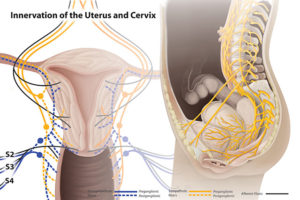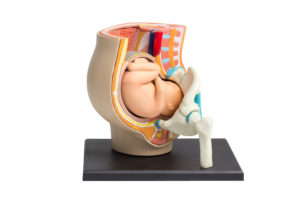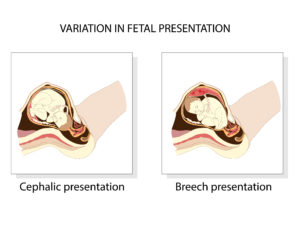Reduce your potential risk of an emergency c-section.
Pain is your body’s way of alerting you of a problem. Some problems make labor and delivery even more difficult, which in turn leads to “fetal distress” at which point the doctor will order a c-section so that your baby is not “damaged.”
Pelvis and low back pain, like all other warning signs, have causes. Some of these causes lead to dystocia, or difficult labor and delivery. “Dystocia” or abnormal progress in labor is a common problem that is being looked at more closely as the incidence of C-Sections at some hospitals in the United States approaches 100%. Dystocia is also loosely defined as failure to progress during labor, lack of progressive cervical dilation or lack of fetal descent. Before we look at the three most common causes of dystocia, lear about CPD and “abnormal progress”, both of which are common reasons that doctors give for the need for c-section. In many circles, CPD and “abnormal progress” are not legitimate reasons to have a c-section, ultimately it’s the parents’ call.
Cephalopelvic distortion (CPD) is often blamed for dystocia and the need for a c-cection. CPD is a situation where the baby’s head is too big to pass through the pelvic canal or pelvic contractions are not great enough to push the baby through. CPD is a diagnosis that must be thought over very carefully as a reason to have a c-section because 2/3 of mothers who are diagnosed with CPD later go on to deliver children vaginally that are larger than the baby involved in the CPD diagnosis.
“Abnormal Progress” is yet to be clearly defined, but suffice to say that more and more women are being rushed to receive pitocin, rushed to push harder, rushed to get an episiotomy, rushed to have vacuum extraction of the baby, rushed into C-Section. Between 50 and 60% of all c-sections performed are a result of dystocia.
Williams Obstetrics Textbook gives 3 reasons as causes of dystocia:
1. Abnormalities of the “expulsive forces” – Uterine forces are either too weak or not well coordinated to efface and dilate the cervix (dysfunction) or the muscles are simply not strong enough (power).
The uterus is a muscle. Muscles are controlled by nerves. If there is irritation, compression, spinal subluxation or other negative influences on the nerves that control the uterus, this environment will contribute to uterine dysfunction. Removal of the cause of interference to the nerve will optimize nerve function to the uterus. Removal of interference to the nervous system is the job of a chiropractor. The 11th thoracic spinal nerve and its’ branches provide nerve supply to the uterus. If abnormalities of the expulsive forces is the cause of your dystocia, chiropractic may be your solution to avoiding a c-section.

The nerves from that control the uterus exit from the low back. Interference in these nerves from spinal subluxation, misalignment, inflammation, tension may contribute to abnormalities of expulsive forces. Chiropractic helps correct nerve interference.
2. Abnormalities of the maternal bony pelvis (pelvic passage)- “Any contractions of the pelvic diameters that diminish the capacity of the pelvis can create dystocia (difficulty) during labor” . Williams Obstetrics further states that t the diameter of the woman’s pelvis is decreased when the sacrum is displaced.
Displacement or subluxation of the sacrum is a problem easily identified and positively affected by a chiropractor and a chiropractic adjustment(s). Small sacral misalignments alter the space in the womb that is significant given the compact nature of the baby’s environment. The first and second causes of dystocia are readily impacted positively by chiropractic care.

Abnormalities of position of the bony pelvis make it difficult for the baby to pass through the pelvis and birth canal. Chiropractic adjustments of the pelvis allow for easier passage and less likelihood that labor will be difficult, prolonged and “call for” a c-section.
3. Abnormalities of Presentation, position or development of the uterus (CH. 19 Williams Obstetrics)
Imbalance of the muscles, ligaments and bony structures of the pelvis and their impact on the uterus and restriction of fetal movement may cause the baby to position itself in a way that is considered abnormal or breech, often resulting in Dystocia in Portland, Maine. This situation is sometimes referred to as intrauterine constraint by medical doctors. Chiropractic evaluation and adjustments that are specific to “The Webster Technique” have been shown to help create and environment where a baby can find a more comfortable position that is more conducive to birthing.

Fetal position that is abnormal (breech), is often caused by pelvic misalignment, which is corrected with chiropractic care. If the baby turns into birthing position with pelvic realignment, there is less likelihood that a c-section will be ordered.
The Webster protocol is a specific chiropractic sacral analysis and adjustment. The goal of the adjustment is to reduce the effects of sacral subluxation/SI joint dysfunction. In so doing neuro-biomechanical function in the pelvis is improved, the baby changes position, and a c-section is possibly averted..
Medical literature and textbooks cite the 3 aforementioned reasons as being primary causes of dystocia. Dystocia has also been shown to be a leading cause of progression toward a c-section birth. If you have low back, pelvic, sacral or tailbone pain, there is a good chance you are also suffering from one or more of the causes of dystocia. If you are an expecting mother intending on having a “natural birth”, it is critical that you understand the often preventable causes of dystocia. Attempting to avoid the causes with preventive chiropractic care is one of the best tools you have to accomplish your goal of a vaginal delivery. Pain in the low back or pelvis is a sign that you may be more likely to have enough difficulty during labor that a c-section will be ordered.
Dr. Lou Jacobs is certified in The Webster Technique and he board certified in perinatal and pediatric chiropractic by The Academy of Chiropractic Family Practice. He is a member of the International Chiropractic Pediatric Association. Dr. Lou has been working with moms and families for over 16 years and is the father of a 9 year old daughter. Jacobs Chiropractic Acupuncture and Perinatal & Pediatric Chiropractic of Maine are located in Portland, Maine.
